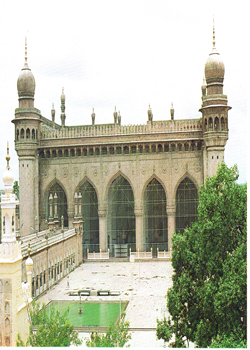 Accession 1550 Dethroned 1550
This is the biggest mosque in Hyderabad and lies 100 yards southw est of Charminar. The name is derived from the Grand Mosque at Mecca on which it is patterned. The hail is 67 metres by 54 metres and 23 metres high. The roof is supported by 15 arches, five on each of the three sides. The western side is blocked by a high wall to provide the Mehrab. At each end are two huge octagonal columns made out of a single piece of granite each and topped by an arched gallery that is crowned by a dome. This mosque is one of the largest in India and can accommodate ten thousand people at a time.
The building of the Mecca Masjid was begun by Sultan Muhammad
Qutb Shah under the direction of Daroga Mir Faizullah Baig and
Choudhary Rangaiah. Nearly 8000 masons and labourers worked on it. Accession 1550 Dethroned 1550
This is the biggest mosque in Hyderabad and lies 100 yards southw est of Charminar. The name is derived from the Grand Mosque at Mecca on which it is patterned. The hail is 67 metres by 54 metres and 23 metres high. The roof is supported by 15 arches, five on each of the three sides. The western side is blocked by a high wall to provide the Mehrab. At each end are two huge octagonal columns made out of a single piece of granite each and topped by an arched gallery that is crowned by a dome. This mosque is one of the largest in India and can accommodate ten thousand people at a time.
The building of the Mecca Masjid was begun by Sultan Muhammad
Qutb Shah under the direction of Daroga Mir Faizullah Baig and
Choudhary Rangaiah. Nearly 8000 masons and labourers worked on it.
The construction work continued during the reigns of Abduliah Qutb
Shah and Abul Hasan Tana Shah. Finally 77 years after it was begun,
Mecca Masjid was completed in 1694 by the Mughal Emperor Aurangzeb.
There is an interesting story regarding this mosque. When the foundation was being laid, Sultan Muhammad Qutb Shah is said to have invited all the pious religious elders of the city. It was announced that the king wanted the foundation stone to be laid by one who had never missed his prayers. None came forward, therefore Sultan Muhammad himself laid the foundation for he had never missed even his midnight prayer since the age of 12.
Tavernier tells us that the stone for the prayer niche was hewn out of a quarry and carried by several hundred pairs of bullocks to the site. One of the rooms in the courtyard is said to contain the hair of the Prophet and other sacred relics. Sultan Muhammad named this mosque “BAITUL
ATIQ”.
It is believed that Muhammad Shah had some bricks made out of the earth brought from Mecca and inserted over the central arch. This is why, the new mosque became popularly known as MECCA MASJID.
At the southern end of the mosque are the marble graves of Asaf Jahi rulers, Nizam Au Khan to Mahboob Ali Khan and other members of the family.
“It is about 50 years since they began to build a splendid pagoda in the town which will be the grandest in all India when it is completed. The size of the stone is a subject of special astonishment, and that of a niche, which is its place for prayer, is an entire rock of such enormous size that they spent five years in quarrying it, and 500 to 600 men were employed continually on its work. It required still more time to roll it up onto conveyance by which they brought it to the pagoda; and they took 1400 oxen to draw it.” (Extract from “Tavernier Travels”).
|
|